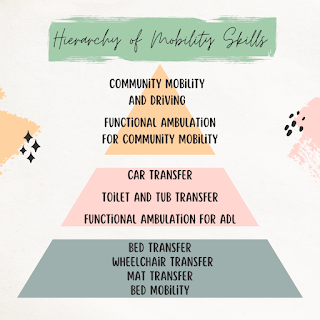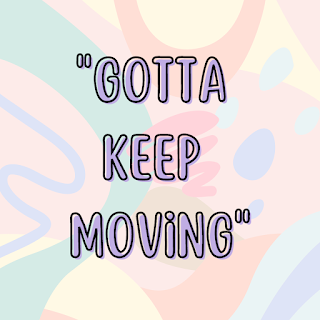Our mobility, or our ability to move our bodies in order to complete daily activities that are necessary and important to us, is an integral part of our confidence and independence. Therefore, ensuring that our client's regain as much mobility as possible, is important for restoring their confidence and independence in daily activities. I will first go over the hierarchy of mobility skills, and then discuss and reflect on my thoughts about this sequence of mobility.
I will be discussing the hierarchy from the bottom up, or 'easiest' to 'hardest'. You will notice that as I move up the hierarchy, the base of support decreases; this makes sense because as one's base of support decreases, their mobility increases, and vice versa. In other words, the less points of contact one has with the surface, the more they will be able to move about in space. With less stability and more mobility, it will require more capabilities from the client such as cognition, balance, strength, and endurance.
Below is a hierarchy chart that depicts the levels of mobility skills that I will be discussing.

Bed mobility is the lowest level of mobility because the entire body is in contact with the bed, therefore there is very little mobility possible. But that does not mean that moving in bed is not important, for example bridging, scooting, or rolling are important for providing pressure relief and being able to position the body in a comfortable position for sleeping. These are also basic skills that the client needs in order to move up the hierarchy to transfers. As we move into transfers, there is a heavy emphasis on center of gravity and sensory input in terms of balance. There are many types of transfers, but before performing any type of transfer, it is important to know the client's capabilities (balance, strength, endurance) and environment (wheelchair, gap, assistive devices). All of this leads up to preparing the client for community and social participation and independence in their daily activities.
Prior to learning about mobility, I did not have a lot of knowledge on the types of mobility and transfers or their hierarchy, but as I am learning about I am learning about the importance of mobility for a client's confidence and independence, as well as the importance to adhere to the levels of hierarchy for client safety. You want to ensure that the client is able to perform the lower levels safely before moving up the hierarchy in order to prevent further injury or falls.



Comments
Post a Comment